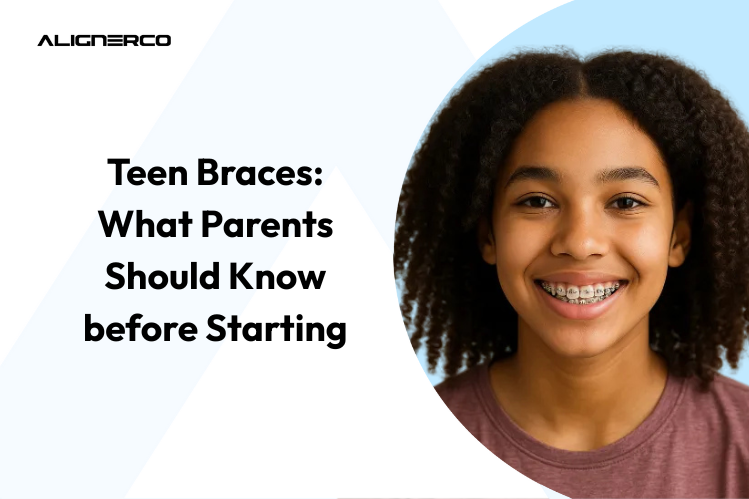
Table des matières
- À quel âge un enfant devrait-il porter un appareil dentaire ? >
- Comprendre les options d'orthodontie pour adolescents >
- Appareils dentaires métalliques
- Appareils dentaires en céramique
- Appareils orthodontiques linguaux
- Aligneurs transparents
- Retirez les aligneurs avant le match
- Utilisez un protège-dents sur mesure
- Utilisez les aligneurs immédiatement après le Jeu
Chaque parent souhaite voir son enfant sourire en toute confiance, et pour beaucoup Pour les adolescents, ce parcours commence par le port d'un appareil dentaire. Qu'il s'agisse de corriger un chevauchement dentaire, En comblant les espaces interdentaires ou en alignant l'occlusion, les soins orthodontiques jouent un rôle important. façonner non seulement le sourire de votre adolescent, mais aussi son estime de soi. Avec le Le nombre d'options disponibles aujourd'hui ne cesse de croître, allant des appareils dentaires métalliques traditionnels aux Avec les aligneurs transparents discrets, choisir la meilleure voie à suivre peut sembler une tâche ardue. décision majeure.
En tant que parent, vous avez probablement un million de questions : Quel type d’appareil dentaire pour adolescents ? Ce traitement convient-il à mon enfant ? Combien de temps durera-t-il ? Quel en sera le coût ? Y a-t-il des risques ou des changements de mode de vie associés à cela ? Non. Seul. Naviguer dans le monde de l'orthodontie peut sembler accablant, surtout si c'est la première fois que vous vivez cette situation avec votre adolescent.
Ce guide complet vise à aider les parents canadiens à prendre des décisions éclairées. Les décisions à prendre concernant les appareils dentaires pour adolescents. Nous vous présenterons les différentes options. types d'appareils orthodontiques disponibles, durée du traitement, coûts prévus et ce qu'il faut savoir Réfléchissez avant de commencer.
À quel âge un enfant devrait-il porter un appareil dentaire ?
Vous vous demandez à quel âge un enfant devrait porter un appareil dentaire ? Vous n’êtes pas le seul parent à vous poser la question. Je pose la question. Essayons de dissiper ce malentendu. La plupart des enfants commencent un traitement orthodontique. Des évaluations sont généralement prévues vers l'âge de 7 ans, mais cela ne signifie pas nécessairement que le port d'un appareil dentaire sera nécessaire. recommandé immédiatement. Pour beaucoup, le traitement proprement dit commence entre l'âge de 9 et 14 ans, lorsque la plupart des dents permanentes ont poussé et que la mâchoire est encore en croissance, facilitant le guidage de l'alignement.
Bien sûr, « l’âge idéal » peut varier en fonction de la santé dentaire propre à chaque enfant. développement. Les signes indiquant que votre adolescent pourrait avoir besoin d'un appareil dentaire comprennent des dents trop serrées ou Dents tordues, problèmes de morsure ou difficultés à nettoyer les dents en raison d'un mauvais alignement. Une évaluation rapide par un orthodontiste est essentielle pour déterminer le moment opportun pour commencer le traitement.
Comprendre les options d'orthodontie pour adolescents

Le monde de l'orthodontie regorge d'options d'appareils dentaires pour adolescents. Examinons-les. Les types d'appareils dentaires les plus courants chez les enfants et les adolescents :
Appareils dentaires métalliques
Les appareils orthodontiques sont l'option la plus traditionnelle pour corriger les problèmes d'alignement dentaire. utiliser des bagues et des fils métalliques qui guident progressivement les dents vers leur position idéale L'alignement. Ils sont très efficaces, mais aussi les plus visibles, et nécessitent un long traitement. Les adolescents souffrant de graves problèmes dentaires peuvent toujours s'amuser. avec des couleurs de bagues pour personnaliser leur appareil dentaire ; ils peuvent choisir meilleures couleurs d'appareils dentaires en fonction de leur style. Ainsi, bien que visibles, elles peuvent être un accessoire de mode. déclaration également.
Appareils dentaires en céramique
Les appareils dentaires en céramique sont similaires aux appareils métalliques et fonctionnent exactement de la même manière. La principale différence réside dans leur apparence. Les bagues des appareils dentaires en céramique sont Transparentes ou de la couleur des dents pour une discrétion optimale. Elles sont de bonnes une option pour ceux qui recherchent une solution discrète, mais elles sont légèrement moins chères. Plus durable que le métal.
Appareils orthodontiques linguaux
Les appareils orthodontiques linguaux sont également fabriqués en métal, mais ils sont placés derrière les dents. les rendant complètement invisibles. Elles sont fabriquées sur mesure, mais peuvent être Inconfortable au début et généralement plus cher.
Aligneurs transparents
Les aligneurs transparents sont la solution moderne pour corriger l'alignement des dents. Elles offrent un traitement discret car elles sont fabriquées en plastique transparent et lisse. Elles sont quasiment invisibles, faites sur mesure, confortables et amovibles. Grâce à ces caractéristiques, les aligneurs transparents sont devenus une option populaire chez les adolescents. et les adultes.
Chronologie du traitement orthodontique
La durée du traitement orthodontique dépend de divers facteurs, notamment La gravité du désalignement, le type d'appareil orthodontique et la façon dont votre adolescent suit les instructions sont des facteurs importants. le plan de traitement. En moyenne, la plupart des adolescents portent un appareil dentaire pendant 12 à 24 mois et aligneurs transparents pendant 6 à 18 mois.
Voici un aperçu général du processus :
Consultation et évaluation
La première étape consiste en une visite chez un orthodontiste. Lors de cette première consultation, les participants ont pu se familiariser avec le processus de consultation. Lors de la consultation, l'orthodontiste procédera à une évaluation complète de l'appareil dentaire de votre enfant. Dents, mâchoire et occlusion. Cela implique généralement des radiographies numériques, des photographies et… Un examen physique peut être nécessaire. L'objectif est d'identifier les problèmes sous-jacents et élaborer un plan de traitement personnalisé.
Empreintes ou scans 3D
Une fois que l'orthodontiste confirme la nécessité d'un traitement, l'étape suivante est Capturer des empreintes détaillées ou des scans numériques 3D de la bouche de votre adolescent. Des moules ou des scans sont utilisés pour concevoir des appareils orthodontiques ou des aligneurs sur mesure qui permettront déplacer progressivement les dents pour un meilleur alignement.
Pose d'appareils orthodontiques ou d'aligneurs
Après la phase de planification, il est temps de commencer ! Pour les appareils dentaires traditionnels, L'orthodontiste collera des bagues sur les dents et y passera des fils métalliques. entamer le processus de réalignement. Si votre adolescent opte pour des aligneurs transparents, Ils recevront leur premier exemplaire, généralement accompagné d'instructions pour les porter. 20 à 22 heures par jour.
Ajustements réguliers ou changements d'aligneurs
Tout au long du traitement, votre adolescent bénéficiera de consultations de suivi régulières. progresser et effectuer les ajustements nécessaires. Pour les appareils orthodontiques, cela signifie resserrer Les fils ou les élastiques doivent être changés. Pour les aligneurs, cela signifie passer à la série suivante. dans la série toutes les une à deux semaines.
Phase de rétention
Même une fois l'appareil dentaire retiré ou la dernière gouttière portée, le sourire de votre adolescent restera intact. Le voyage n'est pas tout à fait terminé. Pour maintenir les dents dans leur nouvelle position, L'orthodontiste vous fournira un appareil de contention. Cette phase de contention est essentielle. car, sans cela, les dents peuvent lentement se déplacer vers leur position initiale au fil du temps.
Le coût des appareils orthodontiques pour adolescents au Canada

Le coût des appareils orthodontiques pour adolescents varie considérablement d'une région à l'autre au Canada et dépend en grande partie de… Le type d'appareil orthodontique choisi et le lieu où vous le faites poser. Voici un exemple. Répartition générale des coûts pour chaque type d'option disponible :
| Types d'appareils orthodontiques | Coût des appareils dentaires |
|---|---|
| Appareils dentaires métalliques | 3 000 $ – 7 000 $ |
| Appareils dentaires en céramique | 4 000 $ – 8 000 $ |
| Appareils orthodontiques linguaux | 8 000 $ – 10 000 $ |
| Aligneurs transparents | 1 000 $ – 7 400 $ |
Heureusement, de nombreuses assurances dentaires couvrent une partie des frais d'orthodontie. Traitement des personnes à charge de moins de 18 ans. Les parents doivent vérifier la couverture à vie de leur régime. limite orthodontique et si l'option choisie est admissible à remboursement. Certaines entreprises acceptent également les comptes de dépenses de santé (CES) ou Comptes de dépenses flexibles (FSA) pour le paiement.
Pourquoi les aligneurs transparents sont les préférés des adolescents
Les aligneurs transparents deviennent rapidement le choix numéro un des adolescents soucieux de leur image. Et à juste titre. Voici pourquoi ils se distinguent :
Esthétique
L'une des principales raisons pour lesquelles les adolescents optent pour des aligneurs invisibles est leur Discrétion assurée. Contrairement aux appareils dentaires métalliques, les aligneurs sont pratiquement invisibles. permettre aux adolescents de redresser leurs dents sans se sentir gênés ou Gênés par leurs sourires.
Amovible
Les aligneurs invisibles sont amovibles, ce qui signifie que les adolescents peuvent les retirer quand manger, boire ou se brosser les dents. Cette fonctionnalité permet une plus grande liberté. flexibilité et commodité, car elle élimine les restrictions alimentaires et simplifie les routines d'hygiène bucco-dentaire.
Confort
Les aligneurs sont fabriqués en plastique lisse, ce qui réduit le risque d'aphtes. et l'inconfort souvent associé aux appareils dentaires traditionnels. C'est particulièrement bénéfique pour les adolescents actifs qui pratiquent un sport ou jouent de la musique instruments.
Durée du traitement réduite
Les aligneurs invisibles permettent d'obtenir des résultats plus efficacement que les aligneurs traditionnels. appareils orthodontiques. La durée du traitement varie en fonction de la gravité de un mauvais alignement, mais de nombreux adolescents bénéficient de durées de traitement plus courtes, leur permettant ainsi de profiter plus tôt de leurs sourires parfaitement alignés.
Moins de visites à la clinique, voire aucune.
Les aligneurs transparents ne nécessitent pas d'ajustements réguliers, ce qui signifie moins de visites chez le médecin. l'orthodontiste, ce qui en fait un choix idéal pour les emplois du temps scolaires chargés. Si vous optez pour le traitement à domicile, vous pouvez suivre vos progrès et Consultez l'orthodontiste confortablement installé sur votre canapé.
Vous cherchez une option adaptée aux adolescents ? Essayez ALIGNERCO

En matière de solutions orthodontiques abordables et adaptées aux adolescents, ALIGNERCO Les aligneurs transparents sont à l'avant-garde. ALIGNERCO propose des aligneurs transparents à distance. Un traitement à la fois efficace et abordable. Leur processus commence par une kit d'empreintes à domicile, examiné par des professionnels dentaires agréés Élaborer un plan de traitement personnalisé. Que votre adolescent soit timide devant l'objectif, Que vous soyez sportif ou que vous souhaitiez simplement corriger votre sourire sans tracas, les aligneurs transparents d'ALIGNERCO sont faits pour vous. offrir un mélange idéal de confort, de flexibilité et de rapport qualité-prix.
Pourquoi ALIGNERCO est idéal pour les adolescents
Voici les raisons pour lesquelles ALIGNERCO est apprécié par de nombreux adolescents au Canada :
- Abordable et options de paiement flexibles
- Apparence discrète
- Confortable à porter
- Traitement à domicile
- Le suivi des progrès simplifié grâce à Application AlignerTracker
- Soutenu par des orthodontistes agréés
Soins orthodontiques pour adolescents
Les soins orthodontiques appropriés pour les adolescents ne se limitent pas au port d'appareils dentaires ou d'aligneurs ; Il s'agit d'instaurer des habitudes durables. Les parents peuvent soutenir leurs adolescents en :
- Encourager un temps de port approprié (20 à 22 heures/jour pour les aligneurs).
- Renforcer les bonnes habitudes d'hygiène bucco-dentaire.
- Surveiller l'utilisation des appareils de contention après le traitement pour éviter rechute .
- Planifier des examens dentaires réguliers.
- Éviter les impacts importants sports avec aligneurs ou des appareils dentaires, car cela pourrait endommager les deux.
Le soutien, la patience et les encouragements des parents peuvent faire toute la différence. pour garantir le succès du traitement.
Ce que chaque parent devrait se rappeler
Entamer un parcours vers un sourire plus droit et plus sain est un grand pas, pas seulement. Non seulement pour votre adolescent, mais aussi pour vous, en tant que parent. Comprendre L'âge idéal pour commencer un traitement et explorer différentes options comme le traitement par métaux lourds Appareils dentaires, appareils en céramique ou aligneurs transparents, chaque choix compte.
La durée du traitement peut varier en fonction des besoins spécifiques de votre adolescent, mais La plupart porteront des appareils dentaires pendant 12 à 24 mois, et des aligneurs pendant 6 à 18 mois. suivie d'une phase de fidélisation cruciale. Les coûts au Canada varient selon… type de traitement et lieu, mais avec assurance, comptes d'épargne santé et plus abordable Outre les options à domicile comme ALIGNERCO, il existe des moyens de rendre le traitement plus facile. accessible.
Pour de nombreux adolescents, les aligneurs transparents sont devenus le choix privilégié, offrant Confort, commodité et discrétion, tout en s'intégrant parfaitement dans un environnement animé. vie scolaire et sociale. Cependant, quel que soit le chemin que vous choisissiez, des soins appropriés, Un suivi régulier et le soutien des parents jouent un rôle majeur dans la réussite. le meilleur résultat.
FAQ
1. Qu'est-ce que j'aurais aimé savoir avant de porter un appareil dentaire ?
Avant de commencer un traitement orthodontique, il est utile de comprendre qu'il comprendra les différentes étapes de la vie d'un patient. avec quelques ajustements. Votre adolescent pourrait ressentir un certain inconfort au début. surtout après le resserrement, et ils devront adapter leur alimentation et Habitudes d'hygiène bucco-dentaire. De légers changements d'élocution sont également possibles.
2. Quelle est la règle 3 concernant les accolades ?
La règle numéro 3 concernant les appareils orthodontiques est d'éviter de mâcher du chewing-gum lorsqu'on porte un appareil. Cette règle s'applique également aux bonbons collants comme les caramels ou les Now and Laters, car ils peut endommager les supports et les fils.
3. Combien de temps un jeune de 14 ans doit-il porter un appareil dentaire ?
Un jeune de 14 ans portera généralement un appareil dentaire pendant environ 18 à 36 mois. la durée exacte du traitement peut varier en fonction de la gravité de le problème et la façon dont leurs dents s'adaptent au fil du temps.
Citations :
Watson, K. (2020a, 20 mars). Qui a besoin d'un appareil dentaire ? Healthline. https://www.healthline.com/health/do-i-need-braces







